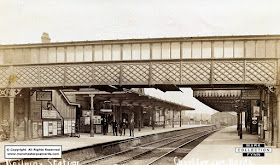It is the sort of discovery which would gladden the heart of
anyone engaged in family history.
.jpg) |
| The Griffth farmhouse, New Brunswick, 2008 |
More so because Roger Hall had disappeared almost a full
century ago and despite the efforts of me in the UK and my Canadian cousins, he
remained the
“lost relative”.
He had been born in 1898 in Birmingham to Montague and Eliza
who were our great grandparents. Theirs
was a tempestuous relationship and after moving from Derby via Birmingham and
London, they settled in Gravesend only to split in 1902. He remained in Gravesend, and she returned to
Derby with her three sons and it was there in the Derby Workhouse that she gave
birth to her last child.
Her return was not an easy one and for most of their childhood
the children were in care before being placed in occupations. Roger and my grandfather proved more troublesome,
and both were sentenced to a naval boot camp.
Granddad went but great uncle Roger opted to go to Canada, migrated as a
British Home Child in 1914.*
 |
| His Attestation Papers, 1915 |
In a few short months he worked on three Canadian farms,
being sent back twice and absconding from the third to join the Canadian
Expeditionary Force.
In the process he
changed his name, lied about his age and gave his aunt as next of kin rather
than his mother.
His unwillingness to conform on the farms was replicated in
the army and he court martialled four times, once for hitting an officer and
three times for absence without leave.
But he survived, returned to Canada, and persuaded his
sister to follow him out on an Empire Assisted Scheme in 1925, and then
sometime after that we lost him.
Until our Marisa found him on the census return for the
Municipality of Coquitlam in British Columbia.
 |
| One of his letters, 1916 |
He was lodging with a family, gave his occupation as a
labourer on a farm and was single.
There is much more to find out which I know our Marisa will
uncover. But its is the first real reference we have after 1925 and confirms
his sister’s belief that he had headed out to the west of Canada, a place still
in the making and as rough and ready with promise of new things as the western
states of its neighbour.
I suspect it was somewhere that would allow a young restless
man an opportunity to reinvent himself.
As it was, he had reverted to his given names of Roger and
Hall, which had been dropped in favour of James Rogers when he ran away and
enlisted. That reversion seems to have
muddied the search but now we have him, living in a community dominated by
single men from China and Japan who were labourers.
His landlord was a James William Williams who was also from
the UK and was a barber aged 42 and perhaps a search may reveal something more
of his Canadian life. I know he was
married to Mary and that their daughter, Elizabeth Mary was born in BC in 1917.
There are several James William Williams who fit the date of
birth in various bits of Britain which in turn may offer up more.
But essentially that is it.
To which some will mutter so what? And follow it up with, “apart from the family
what interest can there be in a man who disappeared a century ago?”
Well, whenever research brings anyone out of the shadows that
is a good result and even more so when he is a member of that group of
children who were migrated to Canada and later other parts of the former
British Empire.
.jpg) |
| Places he knew, St John River, NB, 2008 |
They were sent from 1870 and a century later some British
organizations were still engaged in settling young people in Australia.
Until recently they were a virtually forgotten group and
while they are still a neglected part of our history at least in Canada the
study of British Home Children has become a serious area of historic study.*
That study has occasioned a serious debate about the motives
of those engaged in the migration, the effects on the young people both at the
time and subsequently, and the contribution they made to the countries they
settled in.
And our great uncle was one of them.
Special thanks to our cousin Marisa Cooper who continued the
search for Roger Hall when I had all but given up.
Location; Canada,
Pictures; One of the farms he stayed at in New Brunswick,
2008, his Attestation papers, 1915, letter from Roger James Hall/James Rogers,
February 2, 1916, from the collection of Andrew Simpson and picture of the Griffith's farmhouse, N.B., Angela Faubert, 2008
*British Home Children, https://chorltonhistory.blogspot.com/search/label/British%20Home%20Children


crop.jpeg)

crop.jpeg)






.jpg)


.jpg)


































